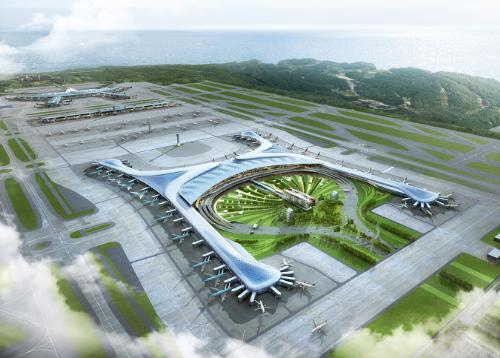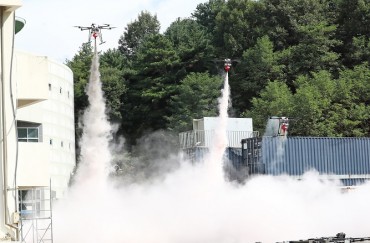
Aerial rendering of Incheon International Airport’s new Terminal 2, which breaks ground September 26, 2013 in Korea. Rendering courtesy Gensler, collaborating design architect with the HMGY Consortium. (image credit: PRNewsFoto/Gensler)
INCHEON, South Korea, Sept. 27, 2013 (Korea Bizwire) – On 26th of November, Incheon International Airport (ICN), Korea’s busiest airport, and the only airport in the world to be voted best in the world by Airports Council International for eight consecutive years, breaks ground on Terminal 2. Gensler, as the collaborating design architect with the HMGY (Heerim-Mooyoung-Gensler-Yungdo) Consortium, designed the $2.5 billion project to be constructed in two phases. When complete, the 72-gate, 7.4-million-square-foot terminal will effectively double the airport’s size and boost its role as a key asset to Korea’s fast-growing economy. The project comprises a second airport control tower, train station, parking facilities and an airside Intra Airport Transit (IAT).
“We designed Terminal 2 to make travel at Incheon even more compelling, offering people unprecedented ease and convenience,” says Keith Thompson, Gensler principal and leader of the firm’s global aviation design practice. He continues: “It’s a large international terminal, yet it will be very intuitive to navigate and present unique experiences like the vast interior gardens featuring native Korean foliage. Travelers will see this as the new benchmark for airports.”
More than a global hub airport, Terminal 2 will build upon ICN’s reputation for being a gateway to Asia as well as one of its top retail destinations. Designed for clarity, ease and comfort, Terminal 2 will incorporate advanced sustainable technologies to create an efficient, healthy and comfortable environment for people. Lush expanses of indoor green space will feature natural daylight, waterfalls, koi ponds, and streams intermingled with luxury lifestyle centers and boutique shopping.
Gateway to Korea
- Among ICN’s goals is to strengthen the airport’s role as a gateway to Asia — providing an alternative to accommodating airports in Hong Kong and Singapore. One of the new terminal’s claims to fame — besides welcoming visitors to the 2018 Pyeongchang Winter Olympics — is that it will shuttle business travelers from train to gate in 13 minutes.
- Gensler, Heerim and their partners in the HMGY Consortium have designed an airport with extraordinary efficiency coupled with design rooted in Korean culture. The building form was inspired by an Asian Phoenix. In Korea, this mythological beast is a symbol of authority, longevity, strength and balance.
- Although it is almost twice as big as Terminal 1, the new terminal is designed for clarity. Passengers arriving by car or train can clearly see the ticketing hall, ticketing counters, security locations, and the IAT. The arrival and departure levels align with and are connected by the IAT, allowing seamless transfer between the terminals and reducing wait times for transfers.
- To give travelers an immediate sense of place, the choice of materials in the terminal, including the signage and graphics, draws on textures and colors that evoke Korean culture and traditions. The flooring in the airport, for example, uses locally quarried granite and traditional Korean wood.
Sustainable Design Inspired by Korean Nature
- Inspired by leaves on trees, photovoltaic cells integrated in the building envelope capture energy from the sun. Working in tandem with skylights to minimize electrical use, they simultaneously illuminate interiors with dappled, shaded sunlight. The result is a comfortable, energy-efficient building, where passengers enjoy natural daylight in the innermost portions of the terminal.
- Inside the terminal, visitors will encounter vast amounts of greenery — acres of plantings that will lighten air-conditioning and ventilation loads. It’s all part of a comprehensive plan for the terminal to be as energy efficient as any in the world by making its own energy and cleaning its own air.
- Vertical cores act as “canyons” between floors, easing passenger wayfinding and bringing natural light and fresh air deep into the building.
The New Aerotropolis: Gateway and Destination
- When it comes to having a customer-first approach, Incheon is a world leader. Retail sales at ICN are in the billions of dollars annually, and the new building will offer an array of attractions that, like a city, make it a compelling destination. Amenities include: VIP lounges; a landside shopping and retail district; aircraft observation deck; a transfer hotel; sculpture and exhibition areas; and gardens featuring waterfalls, indoor streams and koi ponds. The retail lifestyle centers offer double-level shopping and remote duty-free pick up of purchases from Seoul.
- The new terminal will build on its “best in the world” credentials with lifestyle destinations distributed throughout the airport as well as two major gardens reflecting the flora, fauna, art and culture of Korea. Within the spacious passenger areas, gently sunlit lounges, restaurants and stores will cater to the expectations of the most sophisticated consumers.
About Gensler
Gensler is a global design firm, with 44 offices and 3,800 employees worldwide. Gensler helps clients succeed by focusing on the needs of the people they serve, whether they are employees, customers, sports fans, students, passengers or guests. Founded in 1965, Gensler has deep expertise in design and architecture across 20 practices, including aviation, commercial office buildings, professional services, retail, planning and urban design, entertainment and hospitality, sports stadia and education facilities. The firm also holds practices focusing on brand strategy, environmental graphic design, mission-critical facilities, and has recently invested in consulting for real estate workplace and sustainable design.
Gensler’s recent projects of note include Shanghai Tower, JetBlue T5 at JFK International Airport, Houston Ballet Center for Dance, Facebook’s global headquarters, Shenbei Arena, Dubai International Financial Center and Duke University’s Kunshan Campus in China.
For more information, visit our website or blog, follow us on Twitter or LinkedIn, or like us on Facebook.
SOURCE : Gensler http://www.gensler.com Via PRNewswire






